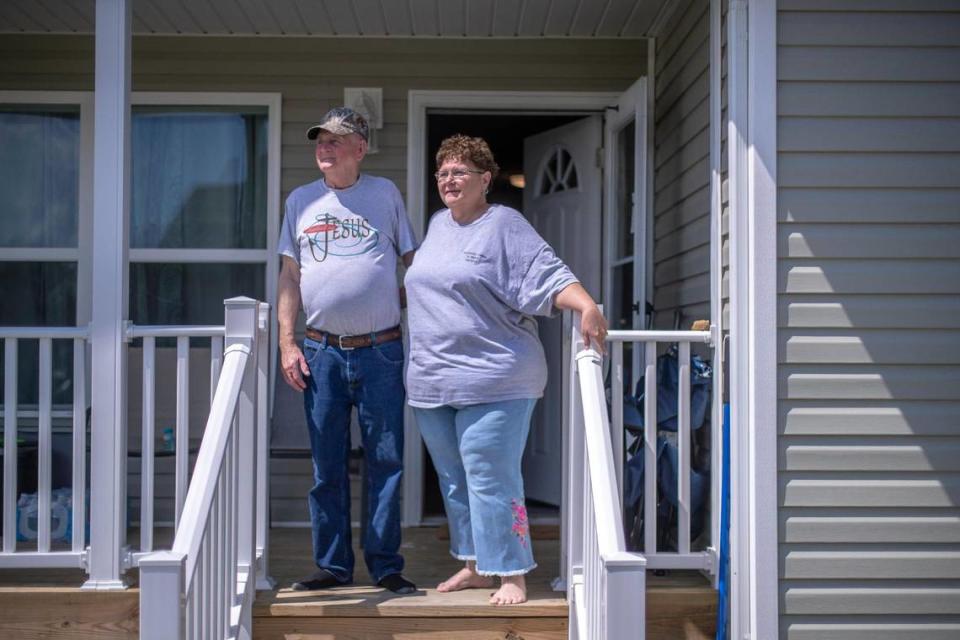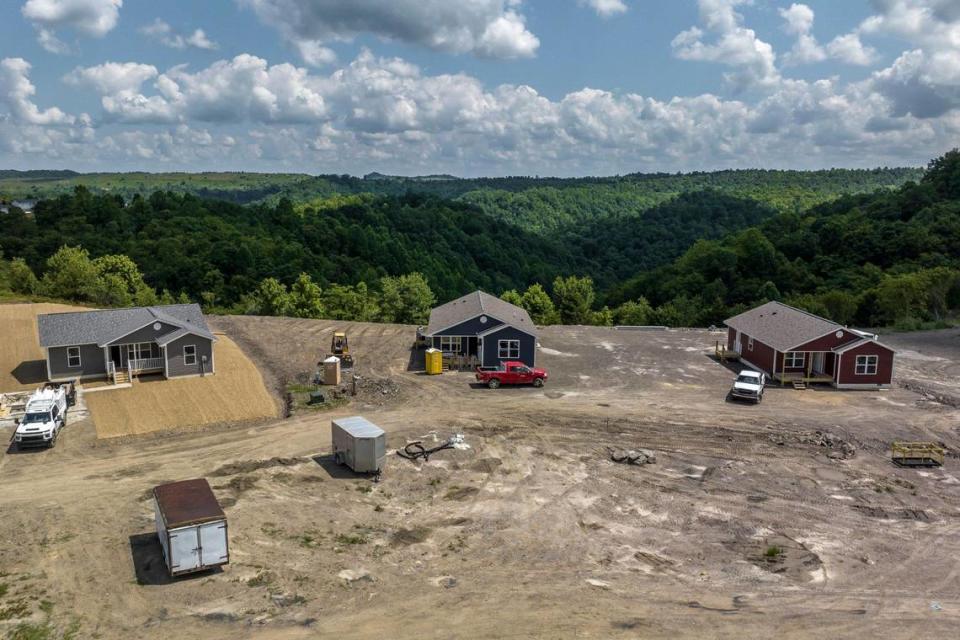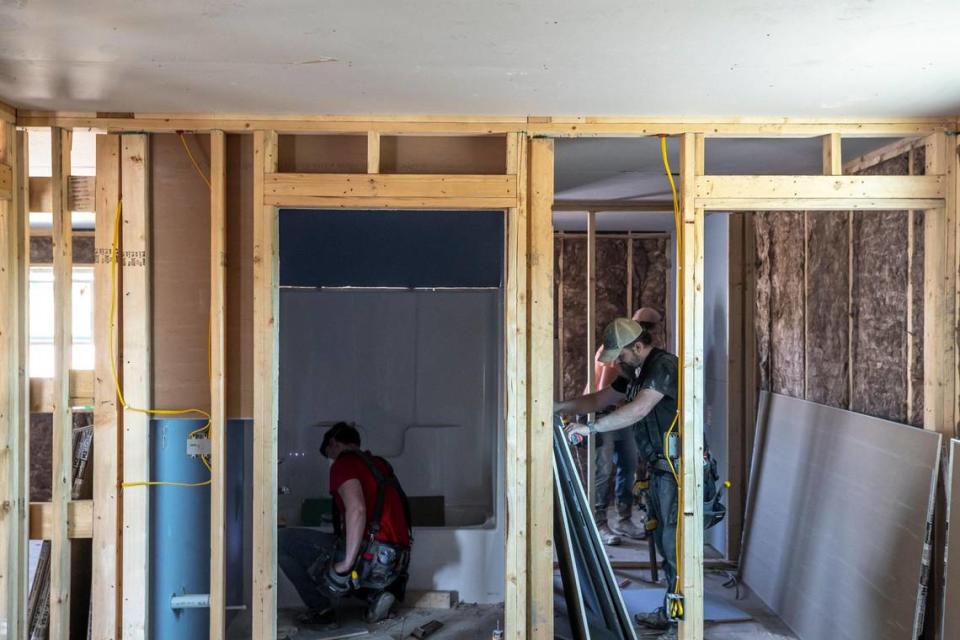A year after Eastern Kentucky floods, where is all the public money for recovery going?
- Oops!Something went wrong.Please try again later.
The Rousseau Volunteer Fire Department serves a 170-square mile slice of Eastern Kentucky that stretches across four different counties.
Before last summer’s devastating flood, about 3,000 people lived within that jurisdiction, estimated Greg Wilson, the department’s chief. A year later, he feels the population has dropped to “easily 2,000.”
“We knew that was gonna happen,” Wilson said.
Still, the non-profit fire department has done everything they can to prevent further depopulation. Since the flood, they’ve assisted over 4,400 families and secured 15 camper trailers, two sheds, an RV and a mini home for flood survivors in Breathitt County. They’ve delivered 25 loads of furniture and close to 5,500 meals. The department continues to run a distribution center and was awarded an East Kentucky Leadership Award in April.
They haven’t received a dollar from the state or federal government.
The department’s lone four-wheel-drive rescue truck “just died on us” from all of the extra hauling work, said Wilson, who now uses his own private vehicle instead. When they looked into getting state disaster funding for a new vehicle, Wilson said his state representative told him the department was ineligible.
“There’s so much red tape and laws,” Wilson said. “Sure, some of them (are) good, but some of them, I mean without these volunteer departments doing like we’ve been doing, what would these people do?”
A conservative estimate would put the amount of federal and state funds pledged to flood recovery in Eastern Kentucky at well over $750 million. But one year after that deadly disaster, much of the largest source of money — almost $300 million in federal disaster recovery funds — is making its way through a slow, months-long application processes.
As those funding processes march on in the background, county officials and housing advocates say they still feel a heightened sense of urgency on the ground as some flood survivors, with little other options, reside in precarious housing situations or consider leaving a region that faced widespread depopulation concerns before the flood.
Government resources are necessary to recover from a disaster that last summer took 45 lives, wreaked havoc on public infrastructure and damaged almost 9,000 homes. A study from the Ohio River Valley Institute estimated it would cost anywhere between $450 to $950 million to rebuild the damaged homes.
“We can’t make things move fast enough,” said Gerry Roll, the CEO of the Foundation for Appalachian Kentucky. “And the fact that we are using government resources, which we have to do, makes that time go even slower.”

The recovery gap
The new home Sherry and George W. Mullins live in now is evidence of the recovery work non-profits have done with the mix of state, federal and philanthropic dollars currently available.
Last year, a helicopter had to rescue the couple near their destroyed River Caney home in Breathitt County. When the flood hit, Sherry was just a month into retirement, she said. In March, they moved into the first home the Hazard-based Housing Development Alliance built for a flood survivor.
They no longer live next to a creek but rather in a near-treeless, growing subdivision near the Hazard airport on what is essentially a former mountaintop flattened by surface mining. They’re adjusting to a less-rural setting but Sherry said they’re getting to the point where “I actually know what retirement is like.”
Relieved to be living out of the floodplain but pained to leave land that’s been home to family for generations, Sherry said she knows they’re fortunate. They had the ability to buy their new home and stayed with family immediately after the flood.
“It’s just heart-wrenching to drive up into some of the communities,” Sherry said, noting that some folks are still living in converted storage buildings.
Many of those still living in more dire circumstances could be caught in the “recovery gap,” said Scott McReynolds, the executive director of the Housing Development Alliance. Just after a disaster, afflicted areas get access to immediate emergency funding and resources. But that’s followed by a months-to-years-long wait for the availability of further federal funding needed for long-term recovery.
In this “recovery gap” — a phrase McReynolds said he borrowed from SBP, a national disaster recovery organization that grew out of long-term recovery from Hurricane Katrina — those who are lower income or otherwise socially vulnerable could run out of initial aid in the first 100 days after a disaster.
Sometimes private insurance can help to bridge the gap, but researchers have estimated only about 5% of the people whose homes were damaged by the flood had insurance. McReynolds said he’d been told by experts to expect a five to seven year long recovery.
“It makes sense because there’s a lot of houses to build,” McReynolds said. “But nobody really talks about where people live for five to seven years if they’re the last person to get recovered.”
The Housing Development Alliance has so far completed more than nine homes and is working on a dozen more, and made about 30 repair jobs. Non-profits like the Appalachian Service Project, HOMES and the Foundation for Appalachian Kentucky are also working on housing.
“We’re excited about that,” McReynolds said. “But it’s also frustrating because we know it’s just really a very small amount of the need.”
What state and federal money has been spent so far
Government resources have come in a few different forms. Between national flood insurance, FEMA and the Small Business Administration, over $281 million in federal funding has arrived in both direct assistance to survivors as well as funding for infrastructure projects in the afflicted counties.
FEMA also has made offers to buy 241 properties in flood-afflicted counties. Totaled together the purchase price would be over $40.9 million. Those flood-prone properties will become green space. Myra Shird, the FEMA federal coordinating officer assigned to the flood for the past year, didn’t want to minimize the needs some survivors still have, “but I will say better days are coming.”
“Recovery takes years,” said Shird, who since 2019 said she has worked more than 20 different disasters across the country. “And it may be in a flash of an eye that you’ve lost everything and it may take years to build back. That is just the nature of recovery.”
The state government has offered two different batches of funding, both of which were approved shortly after the July floods. Via executive order, Gov. Andy Beshear authorized the creation of the Team Eastern Kentucky Flood Relief Fund, which has raised over $13 million through donations. That fund — which provided direct payments to survivors, paid for funerals and has already paid for some home construction — is now the subject of a state audit.
Then weeks after the flood, the state legislature approved a $213 million aid package called the Eastern Kentucky State Aid Funding for Emergencies, or EKSAFE fund. According to monthly updates provided to the legislature, approximately $96.5 million, or about 45% of that money, had been awarded through the end of June.
Distribution of the EKSAFE fund was assigned to various state departments and offices. Most of the money so far distributed has been done by Kentucky Emergency Management. The office has nearly exhausted the $65 million left in its charge on higher ground communities, various cleanup expenses and helping local governments (fiscally strained by unexpected disaster costs) still pay their everyday bills.
Local governments “need to continue to pay their sheriff’s department, their local jail employees, the sanitation workers,” said state budget director John Hicks. “So those funds have been kind of crowded out by the front-end expenses to respond to the immediate disaster.”
In the most recent legislative session, state lawmakers carved out $10 million from the EKSAFE fund specifically for housing. The Kentucky Housing Corporation, which will be in charge of administering that money, told the Herald-Leader the application process isn’t open yet.
‘Building homes to building neighborhoods’
Various other federal programs like the Appalachian Regional Commission, Small Business Administration and USDA have also made grants and loans available to rebuilding flood survivors. But the biggest pot of money is the nearly $423 million in federal CDBG-DR funds.
That money, called CDBG-DR funds because it comes from the Community Development Block Grant-Disaster Recovery program, is given to the state to distribute after it comes up with an approved plan. The money does have some stipulations.
First, $123 million of it is specifically for recovery from extreme weather in 2021. Large portions will go toward Western Kentucky tornado recovery but some is for severe flooding events in the eastern part of the state. That money was just made available for applications from local governments in May 2023. The first of this funding to hit the streets — $1.3 million for construction on apartments and the county courthouse in Breathitt County — was announced on July 11 by Beshear.
Another $300 million directed toward just flood recovery was approved by Congress this year. It could be the end of this year before the state’s action plan makes its way through the reviews, meetings and public comment periods necessary for approval, said Michelle Allen, the executive director for the Kentucky River Area Development District, which is working on many of the grants bringing money to the hardest-hit counties.
When that money is unlocked, Beshear said it could be used to build close to 600 homes, many of which would be located in higher ground communities.
“We’re gonna go from building homes to building neighborhoods pretty quickly,” Beshear said.

Disaster finance
In Carrie, a Knott County community on the banks of Troublesome Creek, a handful of flood survivors gathered at a local church in mid-July. They were there to hear county-level officials and non-profit resource groups explain what the CDBG-DR funds are, connect with needed resource groups and share ideas on how the money should be used.
The meeting was one of several listening sessions hosted in the worst-hit counties by the Kentucky River Area Development District and Berea College’s Brushy Fork Leadership Institute. The first occurred late last fall and winter, said Donna Daniels, the executive director at Brushy Fork.
At those earlier meetings, organizers heard about people living in dire conditions like tents or tarped-in porches, Daniels said. Six months later, they’re hearing more from folks who need drywall or flooring.
The flood survivors attending in Carrie were in various stages of recovery. Even with outside help from non-profits or government sources, the personal finances of recovery can be straining.
Della Ritchie and her husband, Reggie, watched their home get carried away by the raging creek. They still owed over $100,000 on the house and have still made payments on it even while living with a neighbor for the past several months. Della said they also make too much money to be eligible for many of the aid programs for low-income families.
“We both work but it takes both of us making a living to survive,” Della said.
The Appalachian Service Project is working to build their new home. The Ritchies gave ASP all the money they got from FEMA and a $20,000 outside donation they received. ASP is covering the rest of the costs.
Karen Mosley is in a different boat. Before the flood, she rented a residence in Carrie. She’s spent much of the past year raising her three grandchildren in a trailer at the Knott County Sportsplex — hard to do, Mosley said, on “next to no income.”
“I just feel like sometimes I’m going to be left behind,” Mosley said.
The fact that she didn’t own a home prior to the flood and with her income level has made it hard for her to understand what aid programs she actually qualifies for, Mosley said. She has a case worker now to help her with the confusing process but mostly she’s “left with more questions than answers.”
“I pretty much stay that way. It’s a long, drawn out process, I understand,” Mosley said. “But it’s the not knowing that bothers me the most. It wouldn’t bother me to wait another year on a home, if I knew I was going to qualify for one.”
Digging a footer
More state money and eventually the CDBG-DR funds will accelerate construction on higher ground communities, Beshear said. But before those public funds can be used, they need to complete an environmental survey.
“If you have been displaced, and it’s a year later, then you’re rightfully frustrated and believe things should go faster,” Beshear told the Herald-Leader. “And candidly, we are frustrated about our inability to use state dollars on some of these higher ground communities until that permitting is done.”
They’re hoping to wrap up that permitting process as fast as possible, he said.
“Building a high ground community takes longer, but we can reimagine what a neighborhood is,” Beshear said.
The money from non-profits is far more “flexible” than government funding, said Roll, the CEO of the Foundation for Appalachian Kentucky. Using government resources requires a lot more scrutiny up front whereas aid from non-profits faces that scrutiny later in the process. Even if non-profits can work faster, they’ll never be able to reach the scale necessary for recovery.
“I could be wildly successful and raise millions of dollars,” Roll said. “But the chances of raising that hundreds of millions of dollars — that’s going to take public support and that’s what takes a lot of time.”
The Foundation for Appalachian Kentucky has tried to put its money to work quickly. They and other non-profits created a fund with about $6 million earmarked for new affordable housing. The foundation is focused on developing one of those higher ground subdivisions, called Chestnut Ridge, on donated land in Knott County with enough space for 57 houses for flood survivors.
“We have the land, we have the resources,” Roll said. “It’s time that we can’t push any faster and that’s what it takes. In the meantime, people are still suffering.”

They’re hoping to start construction later this year but a lot has to happen in conjunction with other partners. A main road has to be built to the site. Available water and sewer is nearby but the plan has to be approved before “we can dig a footer.”
County governments are also crafting their plans for how they might use the CDBG-DR funding. Floyd County is working on a grant to acquire land for three different new subdivisions within the county, said Robbie Williams, the county’s judge-executive. Close to 150 home sites in the county that have been affected by flooding have been bought out through various federal programs.
For those families that might otherwise leave, Williams is hoping instead they can offer them a free lot to build a home on. Williams said he’s hoping they’d be able to offer those sites within 18-24 months.
“It takes time,” Williams said. “Well, unfortunately, we don’t have time. We’re in an environment here in Eastern Kentucky, with the economy the way it is, and the decline of coal, that for these folks, this is just a another reason for them to leave the region.”

